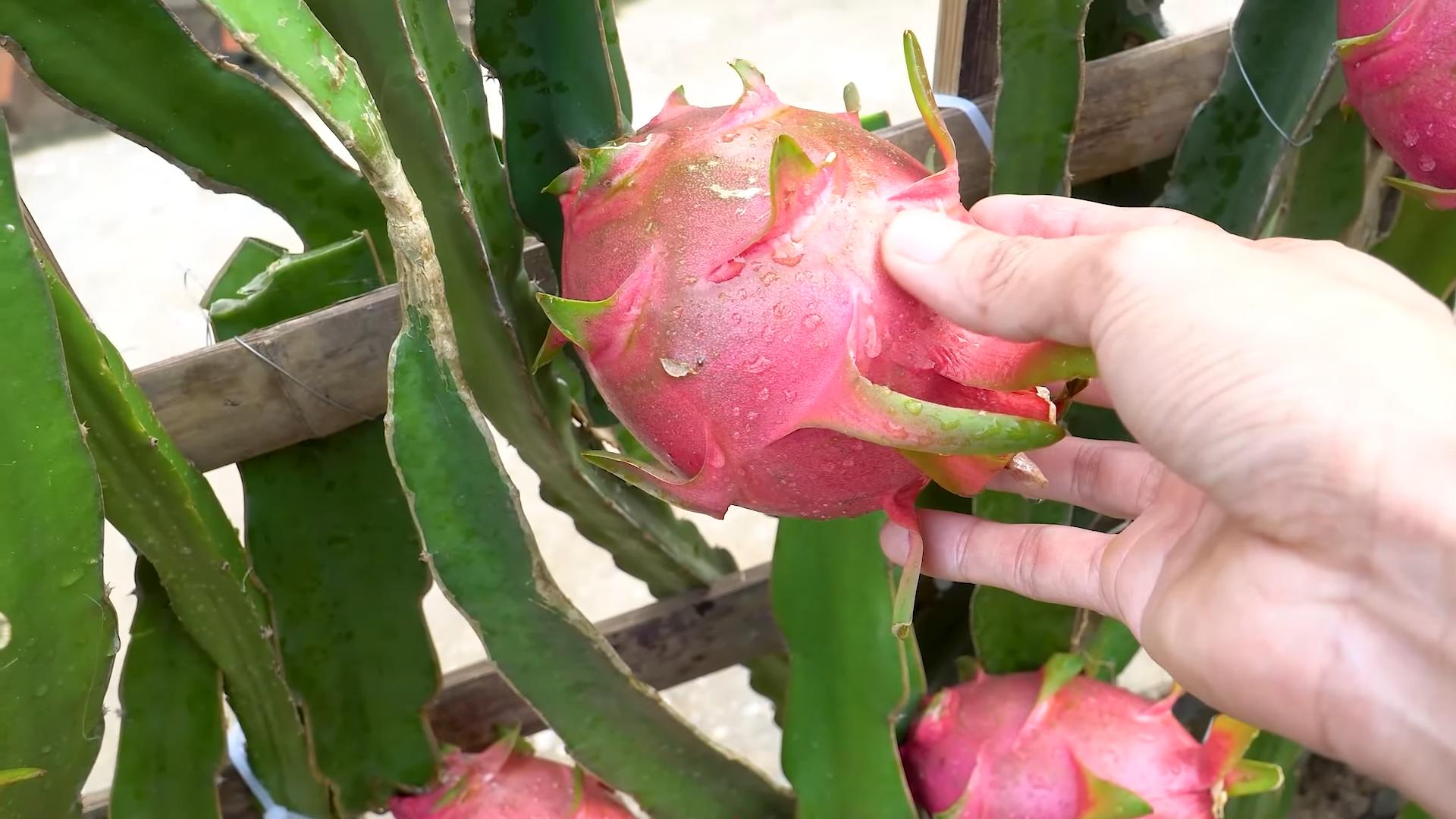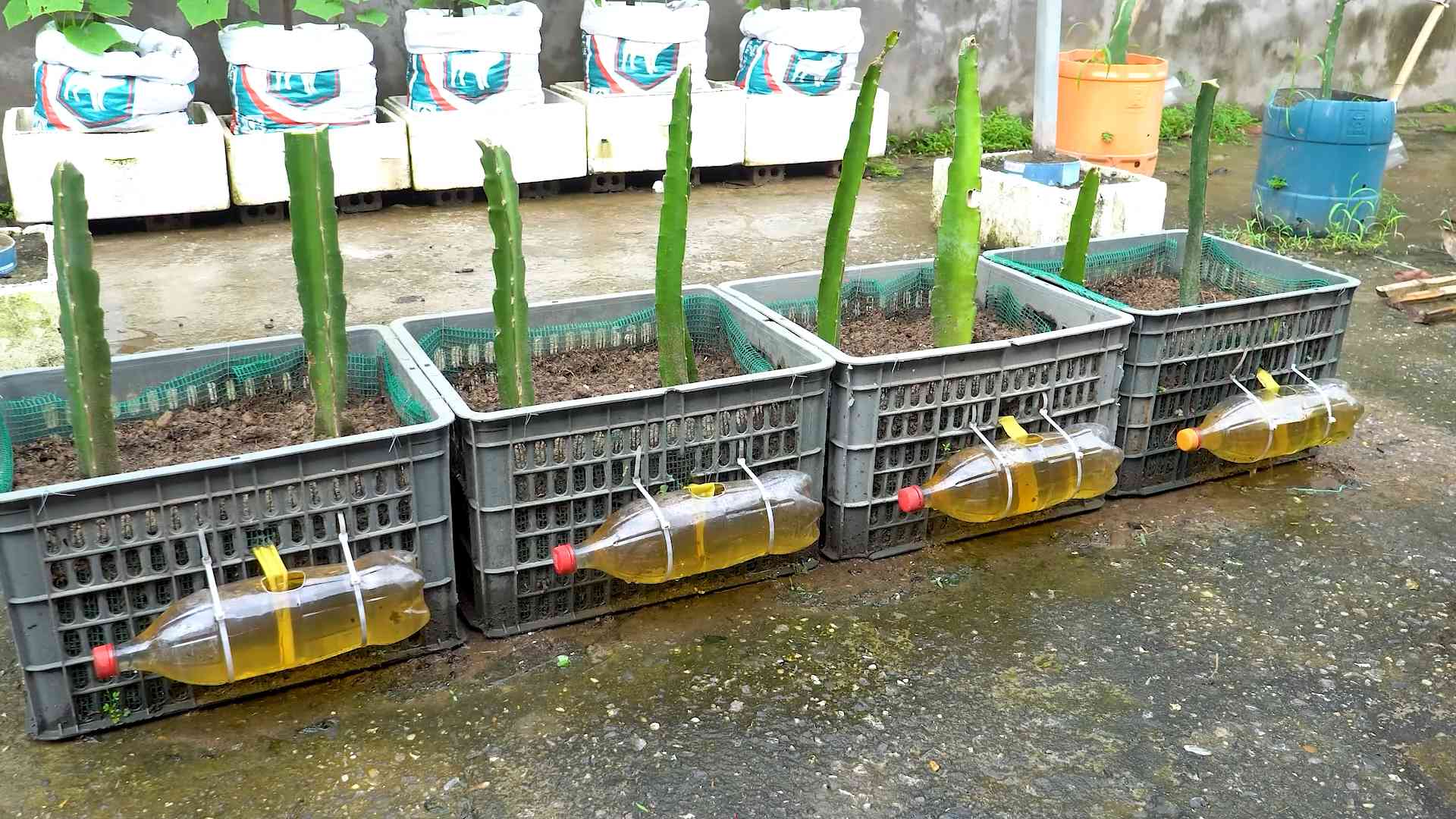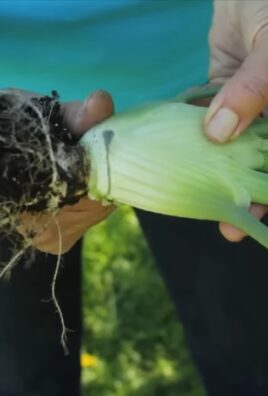Growing Red Dragon Fruit might seem like an exotic dream reserved for tropical climates, but I’m here to tell you that with a few clever tricks and a dash of DIY spirit, you can cultivate this vibrant fruit right in your own backyard – or even indoors! Forget those expensive grocery store prices; imagine plucking your own juicy, sweet Red Dragon Fruit straight from the vine.
The Dragon Fruit, also known as pitaya, boasts a rich history rooted in Central and South America, where it was a staple food for centuries. Its vibrant color and unique flavor have since captivated cultures worldwide, making it a sought-after ingredient in everything from smoothies to salads. But beyond its culinary appeal, the Dragon Fruit plant is also a stunning ornamental piece, adding a touch of the tropics to any space.
Why should you embark on this DIY adventure? Well, for starters, growing Red Dragon Fruit yourself guarantees you’re enjoying a fruit free from harmful pesticides and packed with nutrients. Plus, it’s incredibly rewarding to nurture a plant from a small cutting to a fruit-bearing beauty. I’ll guide you through simple, cost-effective methods to create the perfect growing environment, select the right variety for your region, and troubleshoot common issues. Get ready to impress your friends and family with your newfound gardening prowess and a taste of the exotic, all thanks to your own green thumb!

DIY: Propagating and Growing Your Own Red Dragon Fruit
Okay, so you want to grow your own Red Dragon Fruit? Awesome! It’s totally doable, even if you don’t have a green thumb. I’m going to walk you through everything I’ve learned about propagating and growing these amazing fruits. Get ready for a little bit of patience, but trust me, the reward of harvesting your own vibrant, delicious dragon fruit is totally worth it.
Getting Started: Propagation from Cuttings
The easiest and fastest way to get your dragon fruit journey started is by propagating from cuttings. Forget seeds for now; cuttings give you a head start and ensure you get the exact variety you’re after.
What You’ll Need:
* A healthy Red Dragon Fruit cutting (about 12-18 inches long). Make sure it’s from a mature plant that produces good fruit. You can usually find these at nurseries or online.
* A sharp, clean knife or pruning shears. Sanitize them with rubbing alcohol to prevent disease.
* Rooting hormone (optional, but it speeds things up).
* A well-draining potting mix (cactus mix works great).
* A pot (at least 6 inches in diameter).
* Watering can or hose.
* Gloves (optional, but helpful to avoid getting poked by the spines).
Step-by-Step Instructions:
1. Prepare the Cutting: Put on your gloves if you have them. Inspect your cutting. You want a healthy, green section with no signs of disease or damage. Using your sanitized knife or shears, make a clean cut at the base of the cutting. Let the cut end callous over for about a week. This helps prevent rot. Just leave it in a dry, shaded place. I usually lean mine against a wall in my garage.
2. Apply Rooting Hormone (Optional): If you’re using rooting hormone, dip the calloused end of the cutting into the powder or liquid according to the product instructions. This isn’t essential, but it definitely encourages root growth.
3. Plant the Cutting: Fill your pot with the well-draining potting mix. Make a hole in the center of the soil deep enough to accommodate the bottom few inches of the cutting. Insert the cutting into the hole and gently pack the soil around it to secure it.
4. Water Sparingly: Water the cutting lightly, just enough to moisten the soil. Dragon fruit are succulents, so they don’t like to be waterlogged. Overwatering is a common mistake!
5. Provide Support (Important!): Dragon fruit are climbing cacti, so they need support from the very beginning. Insert a sturdy stake or trellis into the pot next to the cutting. As the plant grows, you’ll need to tie it to the support. I use soft garden twine.
6. Find the Right Spot: Place the pot in a warm, sunny location. Dragon fruit need at least 6 hours of sunlight per day. A south-facing window or a sunny patio is ideal.
7. Be Patient: Rooting can take several weeks, even a couple of months. Keep the soil slightly moist, but don’t overwater. You’ll know the cutting has rooted when you see new growth emerging.
Transplanting and Setting Up for Long-Term Growth
Once your cutting has rooted and started to grow, it’s time to think about transplanting it into a larger pot or even directly into the ground (if you live in a warm climate).
What You’ll Need:
* Your rooted dragon fruit cutting.
* A larger pot (at least 15 gallons) or a suitable spot in your garden.
* Well-draining potting mix (for pots) or well-draining soil amended with compost (for the ground).
* A very sturdy trellis or post (at least 6 feet tall). Dragon fruit get BIG!
* Gardening gloves.
* Watering can or hose.
* Fertilizer (specifically formulated for cacti or succulents).
Step-by-Step Instructions:
1. Choose Your Location: Dragon fruit thrive in warm climates (USDA zones 9-11). If you live in a colder area, you’ll need to grow them in pots so you can bring them indoors during the winter. Choose a location that gets at least 6 hours of sunlight per day and has well-draining soil.
2. Prepare the Soil: If you’re planting in a pot, fill it with a well-draining potting mix. If you’re planting in the ground, amend the soil with compost to improve drainage and fertility. Dragon fruit don’t like soggy soil.
3. Install the Trellis: This is crucial! Dragon fruit are climbing cacti, and they need a strong support structure. A sturdy trellis or post is essential. I recommend a post that’s at least 6 feet tall and 4 inches in diameter. You can also use a metal T-post. Make sure it’s securely anchored in the ground.
4. Transplant Carefully: Gently remove the dragon fruit plant from its original pot, being careful not to damage the roots. Dig a hole in the new pot or in the ground that’s large enough to accommodate the root ball. Place the plant in the hole and backfill with soil, gently packing it around the roots.
5. Water Thoroughly: Water the plant thoroughly after transplanting. This helps settle the soil and encourages root growth.
6. Tie to the Trellis: As the dragon fruit plant grows, you’ll need to tie it to the trellis. Use soft garden twine or strips of cloth to avoid damaging the plant. Train the main stem to grow vertically up the trellis.
7. Fertilize Regularly: Dragon fruit are heavy feeders, so they need regular fertilization. Use a fertilizer specifically formulated for cacti or succulents, following the instructions on the label. I usually fertilize mine every month during the growing season (spring and summer).
Ongoing Care: Watering, Pruning, and Pest Control
Once your dragon fruit plant is established, it’s important to provide ongoing care to ensure it stays healthy and productive.
Watering:
* Water deeply but infrequently. Let the soil dry out completely between waterings. Overwatering is a common cause of problems.
* During the growing season (spring and summer), you’ll need to water more frequently than during the dormant season (fall and winter).
* Check the soil moisture regularly by sticking your finger into the soil. If it feels dry, it’s time to water.
Pruning:
* Pruning is essential for shaping the plant and encouraging fruit production.
* Remove any dead, damaged, or diseased branches.
* Prune back the main stem to encourage branching.
* Once the plant reaches the top of the trellis, prune the branches to encourage them to cascade down. This will create a “weeping” effect and make it easier to harvest the fruit.
* I usually prune mine in the late winter or early spring, before new growth begins.
Pest Control:
* Dragon fruit are relatively pest-resistant, but they can be susceptible to certain pests, such as aphids, mealybugs, and scale.
* Inspect your plants regularly for signs of pests.
* If you find pests, treat them with insecticidal soap or neem oil.
* You can also use beneficial insects, such as ladybugs, to control pests.
Pollination:
* Most dragon fruit varieties are self-pollinating, but some require cross-pollination.
* If you’re not getting fruit, you may need to hand-pollinate the flowers.
* To hand-pollinate, use a small paintbrush to transfer pollen from one flower to another.
* The flowers open at night and only last for one night, so you’ll need to be quick!
Harvesting Your Dragon Fruit
This is the moment you’ve been waiting for! Harvesting your own dragon fruit is incredibly rewarding.
When to Harvest:
* Dragon fruit are typically ready to harvest about 30-50 days after flowering.
* The fruit will turn from green to bright red or pink (depending on the variety).
* The skin will become slightly soft to the touch.
* The “wings” or scales on the fruit will start to dry out.
How to Harvest:
* Use a sharp knife or pruning shears to cut the fruit from the stem.
* Leave a small piece of the stem attached to the fruit.
* Handle the fruit carefully to avoid bruising.
Storing Your Dragon Fruit:
* Dragon fruit can be stored in the refrigerator for up to a week.
* You can also freeze dragon fruit pulp for later use.
Troubleshooting Common Problems
Even with the best care, you might encounter some problems along the way. Here are a few common issues and how to address them:
* Yellowing Leaves: This can be caused by overwatering, underwatering, nutrient deficiencies, or pests. Check

Conclusion
So, there you have it! Growing Red Dragon Fruit at home might seem like a tropical dream, but with a little patience, the right knowledge, and a dash of dedication, you can transform your backyard into a vibrant, fruit-bearing oasis. This DIY project isn’t just about cultivating exotic fruit; it’s about connecting with nature, learning new skills, and enjoying the unparalleled satisfaction of harvesting something you’ve nurtured from the ground up.
Why is this a must-try? Because store-bought dragon fruit simply can’t compare to the flavor and freshness of homegrown. Plus, you’ll avoid the pesticides and long transportation times that often diminish the quality of commercially grown fruit. Imagine biting into a juicy, perfectly ripe Red Dragon Fruit, knowing you were the one who made it happen. That’s an experience worth pursuing!
But the benefits extend beyond just the taste. Dragon fruit is packed with antioxidants, vitamins, and fiber, making it a healthy and delicious addition to your diet. Growing your own ensures you have access to this nutritional powerhouse whenever you crave it.
Don’t be afraid to experiment! Consider these variations to personalize your dragon fruit growing journey:
* Trellis Designs: Get creative with your trellis system. While a simple post works, you can build elaborate structures that add visual appeal to your garden. Think arches, pyramids, or even living fences.
* Companion Planting: Explore companion plants that can benefit your dragon fruit. Marigolds can deter pests, while legumes can enrich the soil with nitrogen.
* Grafting: For faster fruit production, consider grafting your Red Dragon Fruit onto a more established rootstock. This technique can significantly reduce the time it takes for your plant to bear fruit.
* Different Varieties: While this article focuses on Red Dragon Fruit, there are many other varieties to explore, each with its own unique flavor and appearance. Experiment with yellow-skinned or white-fleshed varieties to add diversity to your harvest.
We understand that embarking on a new gardening adventure can be daunting, but we’re confident that with the information provided, you’re well-equipped to succeed. Remember to start small, be patient, and don’t be afraid to learn from your mistakes. Gardening is a journey, not a destination.
We wholeheartedly encourage you to give this DIY trick a try. The rewards – both tangible and intangible – are well worth the effort. And most importantly, we want to hear about your experiences! Share your successes, your challenges, and your tips in the comments below. Let’s build a community of dragon fruit enthusiasts and learn from each other. Your insights could be invaluable to other aspiring growers.
So, grab your gardening gloves, prepare your soil, and get ready to embark on the exciting journey of growing your own Red Dragon Fruit. Happy gardening!
Frequently Asked Questions (FAQ)
Q: How long does it take for a Red Dragon Fruit plant to produce fruit?
A: Generally, Red Dragon Fruit plants can start producing fruit within 6-12 months if grown from cuttings. Plants grown from seeds may take significantly longer, typically 2-5 years. The time to fruiting also depends on factors like climate, soil quality, and the overall health of the plant. Providing optimal growing conditions, including plenty of sunlight, well-draining soil, and regular fertilization, can help accelerate fruit production. Grafting onto a mature rootstock is another method to speed up the process.
Q: What kind of soil is best for growing Red Dragon Fruit?
A: Red Dragon Fruit thrives in well-draining soil that is slightly acidic to neutral (pH 6.0-7.0). The soil should be rich in organic matter to provide essential nutrients. A mixture of sandy loam, compost, and well-rotted manure is ideal. Avoid heavy clay soils, as they can retain too much water and lead to root rot. Amending the soil with perlite or vermiculite can improve drainage. Regular soil testing can help you determine if any amendments are needed to achieve the optimal pH and nutrient levels.
Q: How much sunlight does Red Dragon Fruit need?
A: Red Dragon Fruit plants require at least 6-8 hours of direct sunlight per day to thrive and produce fruit. In hotter climates, providing some afternoon shade can prevent sunburn. Insufficient sunlight can result in poor growth, reduced flowering, and lower fruit production. When growing indoors, supplement with grow lights if natural sunlight is limited.
Q: How often should I water my Red Dragon Fruit plant?
A: Water your Red Dragon Fruit plant deeply but infrequently, allowing the soil to dry out slightly between waterings. Overwatering can lead to root rot, which is a common problem for dragon fruit. The frequency of watering will depend on factors like climate, soil type, and the size of the plant. During the growing season (spring and summer), you may need to water more frequently than during the dormant season (fall and winter). Check the soil moisture regularly by inserting your finger a few inches into the soil. If it feels dry, it’s time to water.
Q: What kind of fertilizer should I use for Red Dragon Fruit?
A: Red Dragon Fruit benefits from regular fertilization, especially during the growing season. Use a balanced fertilizer with an NPK ratio of 10-10-10 or 15-15-15. Apply the fertilizer according to the manufacturer’s instructions, typically every 2-3 months. You can also supplement with organic fertilizers like compost tea or fish emulsion. Avoid over-fertilizing, as this can damage the plant. During the flowering and fruiting stages, switch to a fertilizer with a higher phosphorus content to promote fruit development.
Q: How do I pollinate Red Dragon Fruit flowers?
A: Red Dragon Fruit flowers are typically nocturnal and rely on bats and moths for pollination. However, in many areas, hand-pollination is necessary to ensure fruit set. Use a small brush to transfer pollen from the stamen (male part) of one flower to the stigma (female part) of another flower. Hand-pollinate in the evening or early morning when the flowers are fully open. Cross-pollination between different varieties of dragon fruit can result in larger and better-quality fruit.
Q: What are some common pests and diseases that affect Red Dragon Fruit?
A: Red Dragon Fruit can be susceptible to pests like aphids, mealybugs, and scale insects. These pests can be controlled with insecticidal soap or neem oil. Root rot is a common disease caused by overwatering and poor drainage. Prevent root rot by planting in well-draining soil and avoiding excessive watering. Fungal diseases can also affect dragon fruit, especially in humid climates. Use a fungicide to treat fungal infections. Regularly inspect your plants for signs of pests and diseases and take action promptly to prevent them from spreading.
Q: How do I prune my Red Dragon Fruit plant?
A: Pruning is essential for maintaining the shape and health of your Red Dragon Fruit plant. Prune regularly to remove dead, damaged, or crossing branches. This will improve air circulation and sunlight penetration, which can help prevent diseases. You can also prune to control the size and shape of the plant. Remove any suckers that grow from the base of the plant. Prune after the fruiting season to encourage new growth.
Q: Can I grow Red Dragon Fruit in a container?
A: Yes, Red Dragon Fruit can be successfully grown in containers, making it a great option for those with limited space. Choose a large container with good drainage holes. Use a well-draining potting mix and provide a sturdy trellis for the plant to climb on. Container-grown dragon fruit may require more frequent watering and fertilization than plants grown in the ground. Place the container in a sunny location and protect it from frost.
Q: How do I know when my Red Dragon Fruit is ripe?
A: Red Dragon Fruit is typically ready to harvest about 30-50 days after flowering. The skin will turn from green to a vibrant red or pink color, depending on the variety. The fruit should feel slightly soft to the touch, similar to a ripe avocado. The “wings” or bracts on the fruit will start to dry out and turn brown. Gently twist the fruit; if it comes off easily, it’s ripe. Overripe dragon fruit will become mushy and may split open.




Leave a Comment